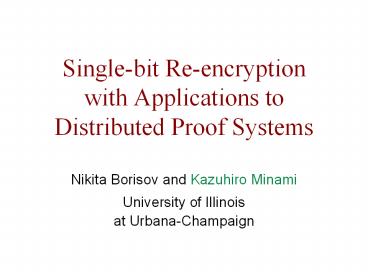Single-bit Re-encryption with Applications to Distributed Proof Systems PowerPoint PPT Presentation
1 / 17
Title: Single-bit Re-encryption with Applications to Distributed Proof Systems
1
Single-bit Re-encryption with Applications to
Distributed Proof Systems
- Nikita Borisov and Kazuhiro Minami
- University of Illinois
- at Urbana-Champaign
2
Distributed Proof System (DPS)
- Construct a proof in a peer-to-peer way
- Useful for distributed authorization
- E.g., SD3, Binder, Grey system, PeerAccess, MK
system etc.
3
Integrity and Confidentiality
- Each peer specifies trust in the correctness of
remote facts using rules with quoted facts - Each peer protects its private facts with
confidentiality policies
MRI 112
Location Server
grant(P) - LocationServer says
doctor_present(room112)
acl(doctor_present(room112)) MRI112
MRI112 ? acl(location(P, room112))
4
Minami-Kotz (MK) algorithm
- A peer sends an encrypted fact to a principal who
is not authorized to see it
- Use a randomized encryption scheme (RSA-OAEP) to
prevent dictionary attacks
Dave
Bob
Alice
grant(P) - Dave says role(P,doctor)
role(Tom, doctor)
acl(role(P,R)) Bob
5
Safety of the MK algorithm
High level analysis
Implementation-level analysis
A covert channel using a random padding in an
encrypted value
No disclosure of confidential facts to
unauthorized parties
6
Our Solution
- Re-encrytion with Goldwasser-Micali (GM)
public-key cryptosystem - Transform the encryption of a single bit into
another, while preserving the bit value - Commutative encryption scheme
- Essentially a n-out-of-n threshold encryption
necessary in distributed proof systems
7
MK Algorithm
acl(f3) p1
p1s knowledge
p2s knowledge
8
MK Algorithm
acl(f3) p1
p2s knowledge
p1s knowledge
9
Attack on the MK Algorithm
p3 is in my proof !
p4 must be in that proof, too
Then, p4 must have fact f3!
?
acl(f3) p1
p2s knowledge
p1s knowledge
10
Attack on the MK Algorithm
acl(f3) p1
p2s knowledge
p1s knowledge
11
Goldwasser-Micali (GM) Scheme with Re-encryption
- Represent a boolean value based on quadratic
residuosity (QR) - True if a (mod n) b2 (mod n)
- False otherwise
- Use re-encryption to convert an encrypted value
to another
David
Bob
Alice
a ( b2 mod n)
a ( b2 mod n)
n pq
12
GM Encryption Scheme
- Public key (n, x) where x is an NQR modulo n
- Private key (p, q) where n pq
- Encryption of a bit b y2xb (mod n) where y is a
random number - With p and q, easy to check whether an encrypted
value is a QR or an NQR
13
Unlinkability via Re-encryption
Dave
Bob
Alice
a
ay2 mod n
n pq
Pick y at random
14
Commutative Encryption
- We cannot support nested encryption in the MK
algorithm (e.g., Ei(Ej(T)) ) - Instead, we support commutative encryption (e.g.,
Ei,j(T) ) - Gives more proving power
- Preserves the same safety property of the MK
algorithm
15
Construction of Commutative Encryption
- Represented as a list of encrypted bits E.g.,
E0,1,...,n (b) (E1(b1),E2(b2),...,En(bn)) - where b b1 ? b2 ? ... ? bn
- To obtain Ei,j (b) from Ei(b)
- Form a pair (Ei(b), Ej(0))
- Re-randomize the pair by picking a random bit b,
and if b 1 then obtain (Ei(?b), Ej(1))
where Ei(?b) xiEi(b)
16
Conclusion
- Identify a covert channel in the MK algorithm
- Apply single-bit re-encryption based on GM scheme
- Design a commutative encryption compatible with
single-bit re-encryption - Future work includes exploration of other
applications such as e-voting and online games
17
Questions?

